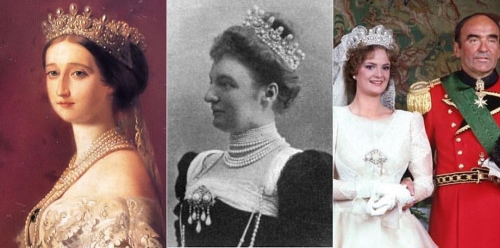Empress Eugénie’s Pearl and Diamond Tiara
/The tiara was made by Gabriel Lemonnier around 1853, and was commissioned by Napoleon III to celebrate his marriage to Eugénie de Montijo (1826-1920). It has an astounding 212 pearls and 1998 diamonds. The tiara that was created for Eugénie is part of a parure which included bracelets, a stomacher, and a six strand pearl necklace.
The pearls and diamonds that were used to create the tiara belonged to the French state treasury in the form of jewelry that had belonged to Empress Marie Louise (1791-1847, second wife of Napoleon I) and the Duchess of Angoulême (1778-1851). Because of this the tiara actually belonged to the state, not Eugenie. The tiara and other state jewels were subsequently returned to the state when she was exiled from France after Napoleon III’s 1870 defeat.
Empress Eugénie, as painted by Winterhalter, Princess Margarethe of Thurn and Taxis, Princess Gloria of Thurn and Taxis
The tiara was part of the crown jewels until the Third Republic decided to sell the entire collection in 1887. The tiara was eventually purchased by Prince Albert I of Thurn and Taxis as a wedding gift to his bride Archduchess Margarethe Klementine of Austria in 1890. The tiara remained a part of the Thurn and Taxis family for the next century. In 1989 the tiara was given to Prince Johannes future wife Gloria who wore the tiara on her wedding day.
Princess Gloria (the “Punk Princess”) was known for her unique fashion combining family jewels with wild outfits and hairstyles. In 1992 her husband, Prince Johannes, died leaving large amounts of debt. As a result Gloria sold a lot of the family’s jewelry collection. Empress Eugénie’s Pearl and Diamond Tiara was sold for 935,000 Deutsche Marks. The tiara did not however end up in another a personal collection. Instead it was bought by the Friends of the Louvre, who gifted it to the museum. It now resides in that Paris museum along with other recovered French jewels.















